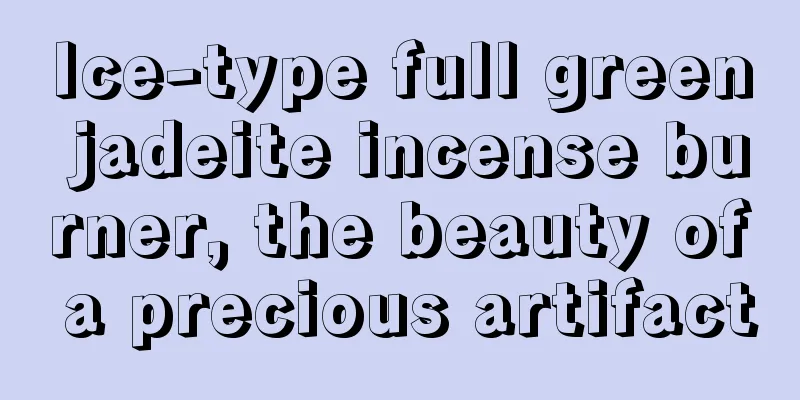What are the characteristics of B-grade jadeite?

|
B-grade jadeite refers to jadeite with poor quality and color that has been corroded by strong acids and alkalis to become jadeite with beautiful appearance and no impurities. Simply put, B-grade jade is jade with fake water and fake species. Identification characteristics of B-grade jadeite Due to the corrosion by chemical reagents, the chemical structure of B-grade jadeite is damaged and the connectivity between its grains is reduced. In order to cover and make up for these flaws, the makers will fill it with gum. Over time, the glue injected into jade B loan will age and crack, losing its lustre, so it has no value-preserving function. The specific gravity of B-grade jadeite is less than 3.3, and the refractive index is greater than or less than 1.66. Under a high-power microscope, it can be seen that the glue injection of B-grade jadeite has formed a small, smooth, orange peel structure with a resin luster and residual bubbles, which have extremely weak reflections and appear cloudy. The bracelet is hung up with a thin wire and tapped lightly with an iron nail, making a hoarse sound.
Depending on the quality of jadeite, the processing of B-grade jadeite can be divided into two types: gluing and not gluing. The gluing process is to use resin glue to consolidate jade B-loan products to increase their strength and transparency. The process is to heat the B-grade jade products (temperature 500-6009T), then corrode them with strong acid, wash them with clean water, dry them, vacuum them, apply glue, and then post-process the appearance before finally taking them out of water. Most of the glue treatments are for jade products with considerable thickness. It can be performed on jade of all textures, but jade with chemical base, bean ground, and taro ground are the most common. After applying glue, the glue-like substance fills the pores inside the jade. In recent years, the industry has mostly used organic wax for gluing. The effect of organic wax is better than traditional white wax, but it cannot solve the problem of dull surface gloss of B-grade jadeite after gluing. Over time, the surface of B-grade jadeite after gluing will still crack. The non-glue treatment refers to the treatment method of corroding B-grade jade products with strong chemical acids, then washing them with clean water and directly draining them out of the water. The non-glue treatment is generally applied to jade slices of good quality or hollow jade products. Because jade is thin, internal impurities can be removed without heating, only strong acid is needed. The pickling time depends on the thickness and amount of impurities. The surface luster of jadeite without glue is better than that of jadeite with glue, but the texture of jadeite becomes more brittle fcgc66 fcpf18 |
<<: Identify B-grade jadeite from five aspects
Recommend
Don't ask whether the carving is expensive or not. If the jade is not carved, it will not become a useful object.
Jade has gem-grade hardness, which makes it much ...
The Rise of Jadeite in Chinese Jade Culture
China is one of the cradles of world civilization...
Is jade investment worthwhile? Should you invest in jade?
Jadeite, the king of jade, itself contains profou...
"Jade is not about color, but about water." This kind of jade is breathtaking.
Jade is not about color, but water. Water head is...
The exquisite jade ornaments collected by the Forbidden City are full of artistic atmosphere and are eye-opening
Jade was introduced to China in the Ming Dynasty,...
Jade Appreciation | 2019 "Lu Zigang Cup" Boutique Exhibition
On the morning of September 27, the 11th China Su...
How to choose jadeite Guanyin for beginners and avoid being tricked
How to choose jadeite Guanyin for beginners textu...
If I wear jade for a long time, will the cotton inside it dissolve? Let's talk about the evolution of jade
Friends who like jade may often hear such words: ...
How is jadeite raw stone formed? How to tell whether jade is authentic?
Jade is a precious gemstone that originates from ...
Are emerald eyes the most precious? What's going on? Jade has eyes.
As the saying goes, eyes are the windows to the s...
If you can't even tell the difference between A, B, and C grade jade, how can you buy jade?
The most basic knowledge point in identifying jad...
Help you choose jadeite carefully!
There is a saying in the industry that goes "...
What is the carving technique of jade? And in what aspects is it reflected?
As the saying goes: three parts material and seve...
It is said that "the type of bracelet should be judged", so how should you choose a pendant?
It is said that "the type of bracelet is jud...
Is blue jadeite really that common?
The blue water material shared today may be criti...









